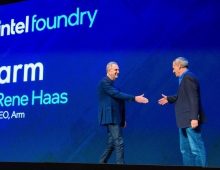
ARM Unveils Energy Efficient A7 Processor
ARM today announced the ARM Cortex-A7 MPCore processor - the most energy-efficient application class processor ARM has ever developed, and big.LITTLE processing - a flexible approach that redefines the traditional power and performance relationship.
The Cortex-A7 processor builds on the low-power leadership established by the Cortex-A8 processor that is at the heart of many of today's popular smartphones. According to ARM, a single Cortex-A7 processor delivers 5x the energy-efficiency and is one fifth the size of the Cortex-A8 processor, while providing greater performance. The Cortex-A7 processor ha sbeen designed to enable "a rich user experience" in sub-$100 entry level smartphones and help connect the next billion people in developing markets.
One of today's technology most significant challenges is how to create a System on Chip (SoC) that meets the conflicting consumer demand for devices with both higher-performance AND extended battery life. Big.LITTLE processing, enabled by Cortex-A7, achieves this by pairing the best of the Cortex-A15 MPCore and efficient Cortex-A7 processors.
"Big.LITTLE processing allows devices to seamlessly select the right processor for the right task, based on performance requirements. Importantly, this dynamic selection is transparent to the application software or middleware running on the processors," ARM said in a statement.
ARM Partners supporting these technologies include Broadcom, Compal, Freescale, HiSilicon, LG Electronics, Linaro, OK Labs, QNX, Redbend, Samsung, Sprint, ST-Ericsson and Texas Instruments.
The efficiency of the ARM architecture is the reason why ARM processors use less power and occupy a smaller footprint. The Cortex-A7 processor occupies less than 0.5mm2, using 28nm process technology, and provides performance in both single and multicore configurations. Used as a stand-alone processor, the Cortex-A7 will deliver sub-$100 entry level smartphones in the 2013-2014 timeframe with an equivalent level of processing performance to today's $500 high-end smartphones.
Big.LITTLE processing combines two different, but compatible processors within the same SoC and allows the power management software to seamlessly select the right processor, or multiple processors, for the right task. The processors appear identical from an applications software perspective.
The 'LITTLE', lowest-power processor - in this case, the Cortex-A7 - runs the Operating System (OS) and applications for basic always-on, always connected tasks, such as social media and audio playback. The OS and apps can then be migrated to the higher-performance processor as demands increase for high end tasks, such as navigation and gaming. The time for this migration is in the order of 20 microseconds.
This flexible approach of choosing the right processor for the right job enables highly optimized processing which results in significant energy savings for common workloads.
The seamless switching of workloads between the two processors is supported by ARM system IP, such as AMBA 4 ACE Coherency Extensions. This ensures full cache, I/O and processor-to-processor coherency between the Cortex-A15 and Cortex-A7, and across the complete system. Software and applications can therefore continue to run unhindered, and unnoticed by the user, as the tasks are rebalanced to provide the optimum big.LITTLE user experience.
Big.LITTLE power management software is developed by ARM ecosystem partners months ahead of silicon availability using ARM DS-5 tools and Fast Model virtual prototyping technology. The virtual platform, available now to ARm's partners, contains the Cortex-A15 and Cortex-A7 processors, as well as cache coherent interconnect System IP, allowing full system software development.

One of today's technology most significant challenges is how to create a System on Chip (SoC) that meets the conflicting consumer demand for devices with both higher-performance AND extended battery life. Big.LITTLE processing, enabled by Cortex-A7, achieves this by pairing the best of the Cortex-A15 MPCore and efficient Cortex-A7 processors.
"Big.LITTLE processing allows devices to seamlessly select the right processor for the right task, based on performance requirements. Importantly, this dynamic selection is transparent to the application software or middleware running on the processors," ARM said in a statement.
ARM Partners supporting these technologies include Broadcom, Compal, Freescale, HiSilicon, LG Electronics, Linaro, OK Labs, QNX, Redbend, Samsung, Sprint, ST-Ericsson and Texas Instruments.
The efficiency of the ARM architecture is the reason why ARM processors use less power and occupy a smaller footprint. The Cortex-A7 processor occupies less than 0.5mm2, using 28nm process technology, and provides performance in both single and multicore configurations. Used as a stand-alone processor, the Cortex-A7 will deliver sub-$100 entry level smartphones in the 2013-2014 timeframe with an equivalent level of processing performance to today's $500 high-end smartphones.
Big.LITTLE processing combines two different, but compatible processors within the same SoC and allows the power management software to seamlessly select the right processor, or multiple processors, for the right task. The processors appear identical from an applications software perspective.
The 'LITTLE', lowest-power processor - in this case, the Cortex-A7 - runs the Operating System (OS) and applications for basic always-on, always connected tasks, such as social media and audio playback. The OS and apps can then be migrated to the higher-performance processor as demands increase for high end tasks, such as navigation and gaming. The time for this migration is in the order of 20 microseconds.
This flexible approach of choosing the right processor for the right job enables highly optimized processing which results in significant energy savings for common workloads.
The seamless switching of workloads between the two processors is supported by ARM system IP, such as AMBA 4 ACE Coherency Extensions. This ensures full cache, I/O and processor-to-processor coherency between the Cortex-A15 and Cortex-A7, and across the complete system. Software and applications can therefore continue to run unhindered, and unnoticed by the user, as the tasks are rebalanced to provide the optimum big.LITTLE user experience.
Big.LITTLE power management software is developed by ARM ecosystem partners months ahead of silicon availability using ARM DS-5 tools and Fast Model virtual prototyping technology. The virtual platform, available now to ARm's partners, contains the Cortex-A15 and Cortex-A7 processors, as well as cache coherent interconnect System IP, allowing full system software development.






















